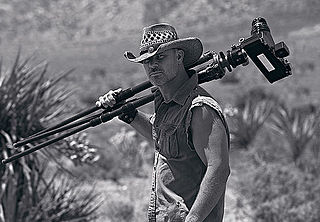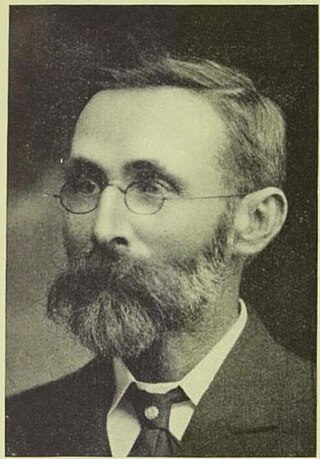Panoramic photography is a technique of photography, using specialized equipment or software, that captures images with horizontally elongated fields of view. It is sometimes known as wide format photography. The term has also been applied to a photograph that is cropped to a relatively wide aspect ratio, like the familiar letterbox format in wide-screen video.

Daidō Moriyama is a Japanese photographer best known for his black-and-white street photography and association with the avant-garde photography magazine Provoke.
Maison Bonfils was a French family-run company producing and selling photography and photographic products from Beirut from 1867 until 1918, from 1878 on renamed "F. Bonfils et Cie". The Bonfils ran the first and, in their time, most successful photographic studio in the city. Maison Bonfils produced studio portraits, staged biblical scenes, landscapes, and panoramic photographs.
Ken Sutcliffe is an Australian sporting journalist and radio and television personality.

Photography in Australia started in the 1840s. The first photograph taken in Australia, a daguerreotype of Bridge Street, Sydney, was taken in 1841.

Peter Lik is an Australian photographer best known for his nature and panoramic landscape images. He hosted From the Edge with Peter Lik, which aired for one season on The Weather Channel.

Samuel Joseph Haskins, was a British photographer, born and raised in South Africa. He started his career in Johannesburg and moved to London in 1968. Haskins is best known for his contribution to in-camera image montage, Haskins Posters (1973) and the 1960s figure photography trilogy Five Girls (book) (1962), Cowboy Kate & Other Stories (1964) and November Girl (book) (1967), plus an ode to sub-saharan tribal Africa "African Image (book) (1967).
Neville Coleman OAM was an Australian naturalist, underwater nature photographer, writer, publisher and educator.
The National Photographic Index of Australian Wildlife was founded as a project of the Australian Museum on 3 June 1969 to compile a comprehensive collection of photographs of Australian bird species. The founder, Donald Trounson, served as the project’s chief executive officer until 1981, when he was succeeded by Ronald Strahan. It was established in association with the National Library of Australia under the direction of a trust chaired by Sir Percy Spender and was the first systematic attempt to compile a comprehensive photographic record of the birds of any country. In 1977 it was expanded to include mammals and, in 1984, reptiles and frogs, with the aim of progressively including other animal groups to become the most comprehensive possible archive of photographs of Australian wildlife and to provide an expanding service to the public, to photographers and to biological science. In November 1980 the Index was incorporated as a part of the Australian Museum and the trust dissolved.
Alfred Donald Trounson OAM was a British diplomat and amateur photographer who settled in Australia in his retirement to become a bird photographer and the founder of the National Photographic Index of Australian Wildlife.
Nick Meers is a British landscape photographer and is the co-author of many published books that include his photography.
Joyce Olga Evans, B.A., Dip. Soc. Stud. was an Australian photographer active as an amateur from the 1950s and professional photographic artist from the 1980s, director of the Church Street Photography Centre in Melbourne (1976–1982), art curator and collector, and tertiary photography lecturer.

Jean Adolphe Braun was a French photographer, best known for his floral still lifes, Parisian street scenes, and grand Alpine landscapes.
David Avison was an American photographer and physicist, best known for his use of a wide angle lens to capture nature, crowds, and portraits. Focused on panoramic photography, Avison photographed Chicago's urban landscapes, turning to Chicago's beaches for his contribution to the documentary project Changing Chicago. Avison spent the bulk of his photographic career in Chicago before moving to Boston in 1997.

The Brenizer method, sometimes referred to as bokeh panorama or bokehrama, is a photographic technique characterized by the creation of a digital image exhibiting a shallow depth of field in tandem with a wide angle of view. Created by use of panoramic stitching techniques applied to portraiture, it was popularized by photographer Ryan Brenizer.

Henry King was an English-born Australian photographer, known for his studies of Australian Aboriginal people and his views of Sydney. King was one of Australia's most significant early photographers, described by the Australian Photographic Review as "stand[ing] high in the esteem of the craft".
Jarrod Castaing is a photographer from Sydney, Australia. Castaing is known for his landscape photographs and limited edition photographic prints from over 50 countries. Castaing was named USA Landscape Photographer of the Year Runner-up in 2014 and exhibited at the Smithsonian Museum of Natural History in Washington, D.C.

John William Lindt (1845–1926), was a German-born Australian landscape and ethnographic photographer, early photojournalist, and portraitist.
Robert Vere Scott (1877, Brisbane –c.1944 United States of America) was an Australian Pictorialist photographer known for his panoramic views. From 1918 he lived and worked in the United States, where he died sometime in the 1940s.
Graham S. Burstow was an Australian photographer. He is known both for his photographic practice and for his service to organisations and photographic competitions, for which he received a Medal of the Order of Australia in 2004. He exhibited widely, both in Australia and overseas, and three photographic books were published that were devoted to his work.







